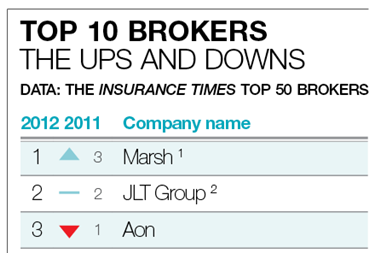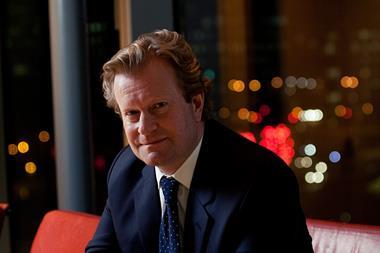Slipping out of the top 10, Arthur J Gallagher joins the next tier of brokers, rounded off at number 20 by a robust-performing Brightside
Arthur J Gallagher | Bluefin | Hyperion | Hastings | Miller | Oval | Capita | Lockton | Giles | Brightside
11th Arthur J Gallagher (UK)
Management: David Ross, chief executive of the UK and international arm of the US giant, has been raiding rival brokers in recent months in a wave of appointments and acquisitions. New hires include Towergate Midlands managing director Andy Smallwood and Canopius head of household underwriting Chris McGinn in early 2012.
In June 2011 Gallagher had swooped for Towergate commercial underwriting director Simon Read and homeowners underwriting managing director Scott Banks among others.
Strategy: The strategic shake-up is all part of Ross’s grand plan to make the broker a major force in UK retail broking. A big step towards this was the May 2011 acquisition of Heath Lambert for £97m, which allowed Gallagher to leapfrog up our rankings to reach the top 10 last year. Former Heath Lambert boss Adrian Colosso was put on gardening leave until 2013 and the business rebranded as Gallagher Heath.
Gallagher followed this coup with the acquisition of Oxygen, including its 21-strong London market team and the Leeds-based corporate risks business. In May it took a 78.5% stake in over-50s broker Insurance Dialogue, which has 172 staff and revenues of £11.7m a year. And in July it bought London-based underwriting agency Contego Underwriting, which specialises in products for the construction and engineering industries globally.
With all of this activity it will come as a disappointment for Ross to see his firm slipping down from ninth to 11th this year. Equally disappointingly, the group made an after-tax profit of $144.1m (£91.5m) in 2011, down 17% on $174.1m for 2010. Total revenues for the year, however, were up to $2.1bn, a rise of almost 15% (2010: $1.9bn).
12th Bluefin Insurance Group
Management: A moderate management shake-up began with chief trading officer Graham Coates resigning in May 2011. (He resurfaced in April 2012 at The Insurance Partnership as executive consultant.) Coates’s responsibilities were transferred to then chief operating officer Mike Bruce, who was made group managing director reporting to chief executive Stuart Reid.
Neil Thornton was promoted at the same time to lead the commercial division, which mainly entails running SME business. Meanwhile, in February Reid was also appointed chairman of the Chartered Insurance Institute’s insurance broking faculty.
Strategy: Bluefin remains the broking business of insurer AXA, although the French parent company sold Bluefin’s employee benefits business to Capita for £50m in April. Other bidders are thought to have included Aon, JLT and Lloyds Banking Group’s private equity arm LDC. The sale is part of a five-year plan to hit a 15% return on equity and 10% annual earnings per share growth.
Bluefin reported improved results for 2011 following job cuts. EBITDA for the year was £17m, up 17% on £15.2m for 2010. The broker is among those to have restricted trading with Groupama following Standard & Poor’s downgrading of the insurer to junk investment grade in June.
13th Hyperion Insurance Group
Management: Up from 19th in last year’s Top 50, Hyperion Insurance Group is growing energetically. The group, which includes wholesale, retail and reinsurance broking company Howden as well as an underwriting business, experienced annual average revenue growth over the past decade of 26%. Profits are up 150% since 2006. Hyperion delivered a 72% increase in profit after tax to £7.5m for the year ending in September, on revenues of £87m.
The firm is set to be transformed by its acquisition of Lloyd’s broker Windsor in June. The combined London broking business will be led by Windsor chief executive John Bennett, reporting to Tim Coles, chief executive of Howden Broking Group.
Strategy: The deal gives Hyperion the critical mass it needs to pull off an IPO, according to analysts, with flotation in the diary for 2013.
For the year ended December 2011, Windsor reported total income of £37.5m and an EBITDA of £12m. So with Hyperion’s earnings last year at £18m, the deal takes the broker up to a £30m earnings business. The insurance group bought out Windsor from its management, staff and institutional backer Hutton Collins Partners in a deal analysts estimate be worth £100m.
14th Hastings Insurance Services
Management: Chief executive Edward Fitzmaurice presided over a 63% profit rise in 2011. Profit after tax rose to £26m for the year, up from £16m in 2010, while gross premiums placed by the group increased 39% to £358m, compared with £257m in 2010. The company, which comprises broker Hastings and insurer Advantage, reported a static combined ratio of 96% in 2011.
Strategy: The motor specialist’s long-awaited flotation remains a subject of intense speculation. Originally planned for this year, Hastings’ current outlook is that the listing will depend on the market’s appetite for an IPO and the firm’s valuation. Hastings suffered a setback in June when finance chief Mark Adams departed only a year into the job. The former Helphire boss had been recruited as part of a plan to boost the senior team ahead of a listing. A replacement is being sought.
Hastings is absorbing the pain of the referral fee ban and, in a further possible blow, analysts have said the Office of Fair Trading’s recent damning report on the motor industry and its expected decision to refer it to the Competition Commission could hinder Hastings’ hopes to pull off an IPO.
Meanwhile, the company is preparing to dip a toe into telematics, with the launch of a pilot product this year.
15th Miller
Management: Miller chief executive Graham Clarke oversaw a 22.5% rise in the firm’s turnover to £102.4m for the year to April 2012. EBITDA was up by 59.2% to £20.1m. In March he was elected chairman of the London & International Insurance Brokers’ Association, succeeding David Margrett. He will focus on regulatory and competition issues and the continuing effort to modernise the market.
Strategy: Miller is a specialist Lloyd’s broker offering insurance and reinsurance. Founded in 1902, the London-based broker has in recent years been steadily opening offices around the world. In the past decade it has set up its European facultative reinsurance team in Brussels and opened offices in Singapore, Hong Kong and Bermuda.
Miller is seeking to grow its book of large corporate clients, which has already doubled in the past two years. As a result it has been enhancing its expertise in recent months by raiding its rivals.
In February James Cunningham joined from Marsh and Ewan Wauchope from Gallagher, bolstering the company’s political risk, trade credit and political violence capabilities. In May it recruited Warren Dann, sales leader for JLT’s Global Risk Solutions. And in July James Venton joined from Arthur J Gallagher and Tom Morley from RK Harrison Group in a bid to expand Miller’s US facultative property book.
16th Oval
Management: Founder Phillip Hodson stepped aside as group chief executive early this year and handed the reins to his deputy Peter Blanc. This came with a management shake-up that included the departure of former managing director Jeff Herdman, who had once been expected to become chief executive.
Blanc has enjoyed a rapid rise to power since selling his Essex-based broking business FMW to Oval in 2007. In five years he’s jumped from regional managing director to deputy chief executive and now boss of one of the UK’s largest independent brokers.
Strategy: How long the company remains independent remains to be seen. Oval could well be a merger target thanks to its strong presence in the increasingly attractive SME and mid-market.
The firm was in the red according to its last annual report for the year ended 31 May, but the after-tax loss of £3m in 2011 was almost half the previous year’s loss of £6.2m. This was achieved partly through increased turnover to £97.1m, up from £95.7m in 2010. EBITDA was down 7% to £15.3m (2010: £16.5m) and net debt £39.7m. Last year there were rumours that Marsh, keen to expand its UK SME business, was interested but the deal foundered on disagreement over the price of the business. Could Giles be the next suitor?
In the meantime, Blanc told Insurance Times that Oval’s relatively low debt means the consolidator, whose shareholders include private equity firm Caledonia, is under no pressure to make acquisitions. He plans organic growth and acquisitions of only smaller brokers.
17th Lockton
Management: UK chief executive Julian James’s plans for organic growth saw brokerage rise by 2.5% to £101m for the year ended April 2011, based on proforma accounts submitted following the transfer of business from Lockton Companies International Ltd to new entity Lockton Companies LLP. Despite this, Lockton fell in this year’s rankings to 17, down from 12 last year.
At global group level, revenues grew 8.5% to $836m (£533m) in the year ended April 2011.
Strategy: Globally, Lockton offers risk management, insurance and employee benefits to companies and individuals. In the UK it is looking to expand mid to high-end corporate businesses, covering FTSE 250 organisations and large private companies, including those operating overseas.
The US-headquartered company claims to be the world’s largest privately owned broker and traditionally keeps a low profile. However, in June chairman David Lockton flew over from the USA to open Lockton’s new Birmingham office, the firm’s second biggest UK office. The 50-staff operation will spearhead a push to grow business in the region. Lockton has 58 offices worldwide, including 10 in the UK.
Lockton indicated a focus on technology-driven risk when it boosted its cyber technology team in London in July with the appointment of Phil Mayes. The former Zurich head of technology professional indemnity has become senior vice-president, global technology and privacy practice.
18th Capita Insurance Services
Management: Capita’s head of general insurance Brent Escott left the firm in July after just over six months in the job. This comes as the broker moves down two places in the Top 50 Brokers ranking from 15 last year. Escott’s surprise departure, which the firm said was mutually agreed, came weeks after he enthused to Insurance Times about his long-term plans for the business in his newly created role.
Finance director Wayne Lewis, former Zurich Global Corporate UK chief executive and chief financial officer, will cover Escott’s role until a permanent replacement is found. He will be assisted by interim corporate development director Phil Zeidler.
Strategy: Escott, who joined Capita a year ago, had overseen several strategic changes, including creating 30 underwriting jobs in Gloucester and building an experienced senior team. His plans had centred on boosting the firm’s diverse UK business, particularly on the commercial side. He also planned to build on Capita’s position as the UK’s largest telematics administrator and was overseeing a tender to service the new Lloyd’s Asian platform.
19th Giles Insurance Brokers
Management: Brendan McManus joined as chief executive in April after his abrupt departure from the post of UK chief executive at Willis. He is now determined to put Giles at the front of the race among the consolidators, but he has a job on his hands.
There have been persistent whispers of rows with insurers, high-profile staff departures and the revelation in May that the broker had abandoned plans for flotation. Giles also made a loss in 2011 and is saddled with net bank debt of £124m. The after-tax loss for the year was broadly flat, at £37.4m compared with £37.1m in 2010, after booking a £24m goodwill charge and £21m interest on its loan notes.
More positively, EBITDA rose 14.7% to £24m (2010: £20.9m) and turnover rose 16.3% to £81m (2010: £69m), while operating margin remained the same at 29%.
Strategy: Giles has seen massive growth over the past 10 years, fuelled by private equity backing, first in the form of Gresham in 2006 and then Charterhouse in 2008. The traditional private equity approach would have been to sell Giles after three or four years, but McManus says Charterhouse accepts that market conditions have changed and it now views Giles as a long-term investment.
20th Brightside
Management: Chief executive Arron Banks quit in June and is plotting a private equity-backed buy-out of the AIM-listed company’s stock to return it to private status. He has been replaced by Martyn Holman, who was insurance broking director.
The rationale, Banks told Insurance Times, was that Brightside’s results have been “fabulous” yet its share price has been dragged down with the rest of the sector. The broker’s share price has been hovering around the 20p mark this year despite a 44% rise in profit.
Brightside made an after-tax profit of £9.4m in 2011, up 44% on the £6.5m it made in 2010. The broker also reported robust trading for the first five months of 2012. Compared with the same period in 2011, like-for-like sales rose 9.3% to £37.1m.
Strategy: Banks is Brightside’s biggest shareholder, with a 15.24% stake. However, his buy-out plan depends on him offering a price acceptable to the firm’s other powerful shareholders, including Aviva, Schroders and Legal & General Investment Management, which will not be easily satisfied.
Meanwhile, Brightside is going from strength to strength, signing high-profile affinity deals in July with Asda Money and Debenhams. In February it acquired its headquarters building near Bristol for £3m.
Hosted by comedian and actor Tom Allen, 34 Gold, 23 Silver and 22 Bronze awards were handed out across an amazing 34 categories recognising brilliance and innovation right across the breadth of UK general insurance.











































No comments yet